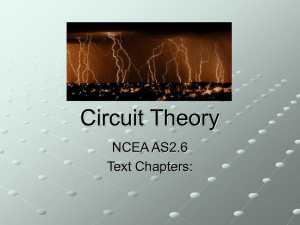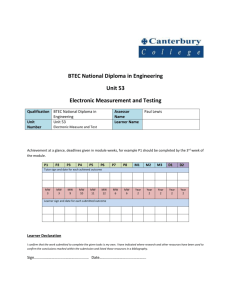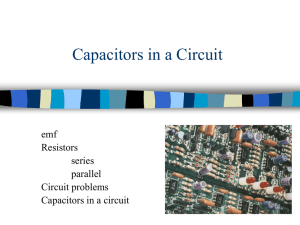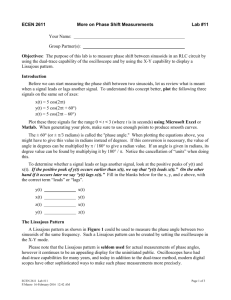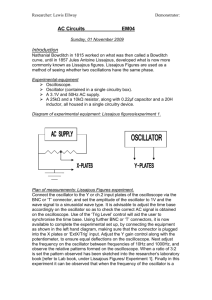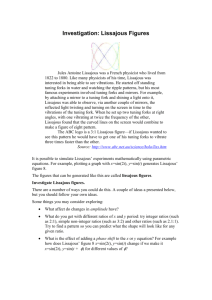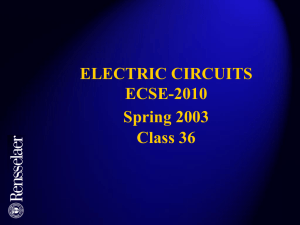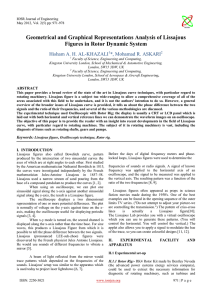Basic experiments of electronics
advertisement
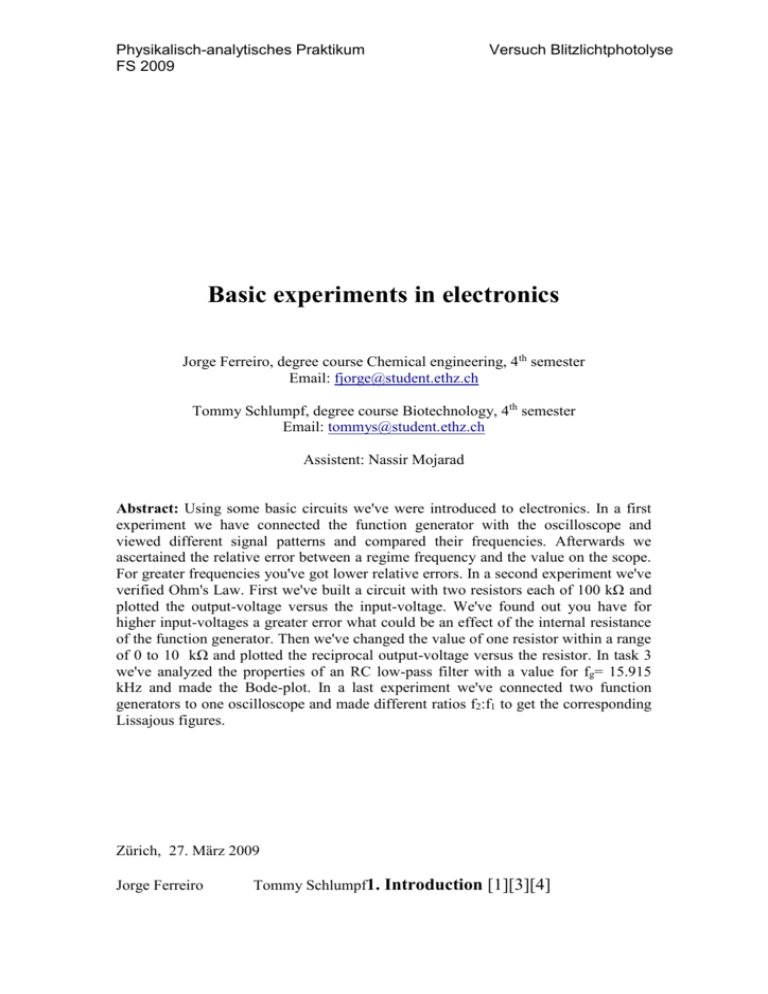
Physikalisch-analytisches Praktikum FS 2009 Versuch Blitzlichtphotolyse Basic experiments in electronics Jorge Ferreiro, degree course Chemical engineering, 4th semester Email: fjorge@student.ethz.ch Tommy Schlumpf, degree course Biotechnology, 4th semester Email: tommys@student.ethz.ch Assistent: Nassir Mojarad Abstract: Using some basic circuits we've were introduced to electronics. In a first experiment we have connected the function generator with the oscilloscope and viewed different signal patterns and compared their frequencies. Afterwards we ascertained the relative error between a regime frequency and the value on the scope. For greater frequencies you've got lower relative errors. In a second experiment we've verified Ohm's Law. First we've built a circuit with two resistors each of 100 kΩ and plotted the output-voltage versus the input-voltage. We've found out you have for higher input-voltages a greater error what could be an effect of the internal resistance of the function generator. Then we've changed the value of one resistor within a range of 0 to 10 kΩ and plotted the reciprocal output-voltage versus the resistor. In task 3 we've analyzed the properties of an RC low-pass filter with a value for fg= 15.915 kHz and made the Bode-plot. In a last experiment we've connected two function generators to one oscilloscope and made different ratios f2:f1 to get the corresponding Lissajous figures. Zürich, 27. März 2009 Jorge Ferreiro Tommy Schlumpf1. Introduction [1][3][4] Physikalisch-analytisches Praktikum FS 2009 Experiment Electronics Generally voltage is the difference of electrical potential in a electronic circuit. The voltage between two points is the energy used to move a point-charge from a low potential to a higher potential. The current is the flow rate of the electric charge. The flow can be uni- or bidirectional, either called “Direct Current” (DC) or “Alternating Current” (AC). AC flow usually changes in sinus form. The sine function can be expressed with: I(,t) I0 e it U(,t) U 0 e it (1) where I0 and U0 are the amplitudes and is the angular frequency. The complex form of the equation is usually preferred because of the easier representation and calculation when phase shiftshave to be taken into account. a variety of components. The simplest are linear Electrical circuits are built with components like resistors, capacitors and coils. Ohm’s Law links resistors with the voltage and current: U R I (2) with R . Resistors can be arranged parallel or serial in the electronic circuit, while the total resistanceof parallel resistors is: 1 1 R i Ri (3) and the total resistance of serially connected resistors is: R Ri (4) i A capacitor is a component that stores charge. The voltage over a capacitor has a 90° phase shift in relation to the input voltage. The capacity of a capacitor (usually a related by: constant) and the voltage C Q U (5) where Q is the charge of the capacitor. Capacitors can also be connected parallel and serial, where the total capacitance of parallel capacitors is: C Ci (6) i and serially connected it’s calculated by: 2 Physikalisch-analytisches Praktikum FS 2009 Experiment Electronics 1 1 C i Ci (7) The property of a coil is its inductance. As soon as time-alternating current flows through a coil it builds a time dependent magnetic flow and at the end of the coil wire a self-induced current forms, directly opposing the input direction of the current, that is stronger if the rate of alternation becomes faster. The inductance of a coil is the proportionality factor described by: L U0 I0 (8) Again, coils can be connected serially and parallel and the total inductance can be calculated for (X) parallel and (Y) serial: 1 1 (9) L i Li L Li (10) i The components mentioned above can be used to create RC- and RLC-Circuits. The RC-Circuit is a low-pass filter, meaning that only lets low frequencies pass and stops (absorbs) all frequencies higher than the cut-off frequency. Fig. 1: RC-Circuit consisting of a resistor and a capacitor. The cut-off frequency can be calculated with: fc 1 2 RC (11) The RLC-Circuit forms a harmonic oscillator using a capacitor, resistor and inductor either connected parallel or in series. The Circuit has a resonant frequency that can be calculated with: 0 1 LC (12) 3 Physikalisch-analytisches Praktikum FS 2009 Experiment Electronics or in Hz f res 1 (13) 2 LC The current flowing at the resonant frequency becomes infinite in an ideal circuit. Fig. 2: RLC-Circuit consisting of a resistor, an inductor and a capacitor. A Lissajous figure is a graph where the x- and y-values are both sine-functions x a1 sin( 1t 1) y a2 sin( 2 t 2 ) (14) For Lissajous figures you can only observe a good graphical representation if the difference between both oscillations is small. Only then the figures will be sharp and will seem three dimensional. For rational ratios between frequency f 1 and f2 you will get a periodical function. In the table below you have all used symbols with their corresponding physical unit. Symbol I U R ω Q C L f Explanation current voltage resistor angular frequency charge capacity inductivity frequency Unit A V Ω Hz C F H Hz Tab. 1: Used physical variables with their corresponding units 4 Physikalisch-analytisches Praktikum FS 2009 Experiment Electronics 2. Experimental 2.1. Electronic equipment Multifunction apparatus: Metex MS-9140 consisting of power supply, frequency generator and counter and digital mulitmeter. Oscilloscope Kikusui DSS 5040 Tektronix DS 2014 Four Channel Digital Storage Oscilloscope Two BNC cables Elements with capacitors, inductors and resistances Remarks: We’ve used the first oscilloscope for experiments 2.2 and 2.3/task B. Afterward we’ve used Tektronix’ one. 2.2. Familiarisation Task A. You had to turn on the oscilloscope and function generator and connect then together by a BNC cable. Task B. Now you should observe different signal forms that were generated by the function generator. The patterns and the corresponding frequencies were plotted rather written. Task C. In this experiment you had to discover how accurate the function generator works finding out the relative error for given frequency regimes (1 kHz, 10 kHz, 100 kHz, 1 MHz) by reading the time-difference between two peaks on the scope. 2.3. Ohm’s Law Fig. 3: Circuit for experiment with Ohm’s Law. Two resistors (each one 100 Ω) connected in series. 5 Physikalisch-analytisches Praktikum FS 2009 Experiment Electronics Task A. Two resistors R1 and R2 each of 100 Ω were connected in series and the outputvoltage was detected. The measured data-points were plotted (U2 vs. U1) to verify (15). (15) Task B. The same configuration as in task A was used but now resistor R1 was variable and the dependence between V2 and R1 was studied. As in task A. you plotted your data points (1/V2 vs. R1) and compared it to what it’s expected from theory. 2.4. Characterisation of an RC low-pass filter You had to construct an RC circuit with C = 10 nF and R = 1 kΩ and calculate the expected value for fg. Now you should calculate the values G(f) and plot |G(f)| versus f in a logarithmic scale. Also you should plot φ versus f also in a logarithmic scale. For a schematic representation of a RC low-pass filter see Fig. 1. x= G( x) )= ( f fg (16) 1 1+x 2 G =arctan( x) (17) (18) 2.5. Characterisation of an RLC circuit Task A You should construct and RLC circuit with R = 1 kΩ and the values for L and C such they yield a resonance frequency of a few ten kHz. All components were connected in series. Now you swept the frequency form a few hundred Hz up to the maximum of the function generator each time measuring |G(f)| and plotting it afterwards versus the frequency in a logarithmic scale. Task B Now we had to find the resonance frequency and ∆f3dB and compare both to their corresponding theoretical values. 6 Physikalisch-analytisches Praktikum FS 2009 Experiment Electronics 2.6. Lissajous figures Task A In the RLC circuit built above you should make the voltage of the capacitor or the inductor the input of channel one (on the oscilloscope) and keep the other channel the output of the function generator. The voltage range on both axis should be equal. Now by changing the frequency you could observe different figures. Task B By connecting a second function generator to the other channel of the scope you could see different Lissajous figures changing the ration between the frequencies of both generators. 3. Results 3.1. Familiarisation Task A You see your input voltage from the function generator as amplitude U(t) on the y-axis and the time t on the x-axes of the oscilloscope. The difference between two maximums is the set frequency. Task B For graphical representation see sketches in lab journal. Basically you have for all three signal forms the same frequency; only the graphical representation on the scope changes. Task C For numeric results see Tab. 2 in appendix. The higher the frequency regime the lower is the relative error. 3.2. Ohm’s Law Task A For graphical representation see Fig. 4 in appendix. The higher the input frequency the higher is the error between the ideal curve – done upon (15) – and the data points with its fitting curve. 7 Physikalisch-analytisches Praktikum FS 2009 Experiment Electronics Task B For graphical representation see Fig. 5 in appendix. Here, we have the same case as above: the value of the reciprocal output-voltage gets the higher the higher R1 becomes. 3.3. Characterisation of an RC low-pass filter For graphical representation see Fig. 6-8 in appendix. In this experiment you’ve verified the function of the low-pass filter. For all values x < 1 the output-voltage will stay approximately constant. For all values x > 1 the curve will fall with a slope of -15.9 ± 10.6 dB. You call this region stopband. 3.4. Characterisation of an RLC circuit It didn’t work because the resulting voltage on the scope only moved up or down (by changing the frequency up or down). Normally the voltage should go up till a certain resonance frequency and then go down. 3.5. Lissajous figures Task A It didn’t work because we couldn’t construct the RLC circuit. Task B For graphical representation see sketches in the lab journal. Basically the seen Lissajous figures on the scope correspond to theoretical figures you’ll expect although they were very difficult to see. 4. Discussion 4.1 Familiarisation Task C We don’t think the accuracy increases with higher frequencies because basically for an electric apparatus you have always the same accuracy given by the producer but with higher frequencies (resting on the same unit, in this case kHz) you will need more digits before the decimal point to represent your value. So behind the decimal point the number of digit decreases and it seems, the accuracy increases. 4.2. Ohm’s Law Task A and Task B 8 Physikalisch-analytisches Praktikum FS 2009 Experiment Electronics Normally all electronic equipment like function generators, inductors etc. have an internal resistance of values up to 1 kΩ. In this case we think we have a greater resistance from the function generator with increasing input-voltage so the outputvoltage will decrease simultaneously. The error in Fig. 5between the fitted curve and the ideal curve is greater than in Fig. 4 although they represent the same the same relation. Due to the defect oscilloscope we first did task B and we suppose the scale for the output-voltage didn’t work properly so we got some inaccurate measurements. Task A was done with the new oscilloscope that worked perfectly so there we have acceptable values. 4.3. Characterisation of an RC low-pass filter We’ve found nearly the expected results. 4.4. Characterisation of an RLC circuit It probably didn’t work because the coils were burned out and didn’t work as they should have. 4.5 Lissajous figures We’ve basically seen the expected figures for the corresponding phase difference. 5. Source [1] Meister, E.; Grundpraktikum Physikalische Chemie, 2. Auflage, vdf Hochschulverlag AG der ETH Zürich, 2006, S. 303 – 327 [2] Meister, E.; Grundpraktikum Physikalische Chemie, 2. Auflage, vdf Hochschulverlag AG der ETH Zürich, 2006, S. 427-435 [3] http://en.wikipedia.org/wiki/RC_circuit, downloaded on 26.03.2009 [4] http://people.sinclair.edu/nickreeder/EET155/PageArt/SeriesRLCac.gif, downloaded on 27.03.2009 9


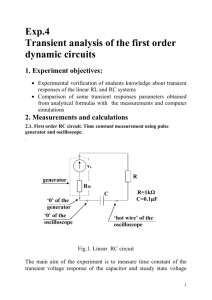

![Sample_hold[1]](http://s2.studylib.net/store/data/005360237_1-66a09447be9ffd6ace4f3f67c2fef5c7-300x300.png)




